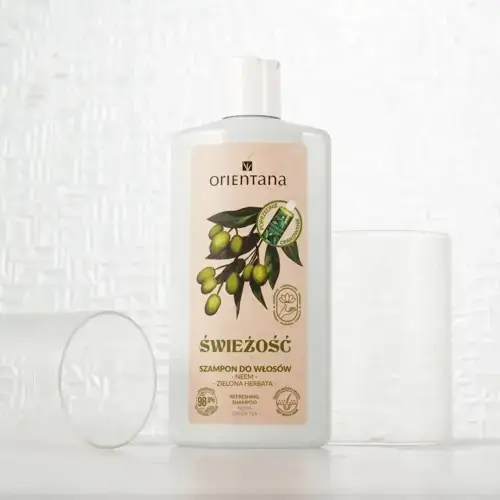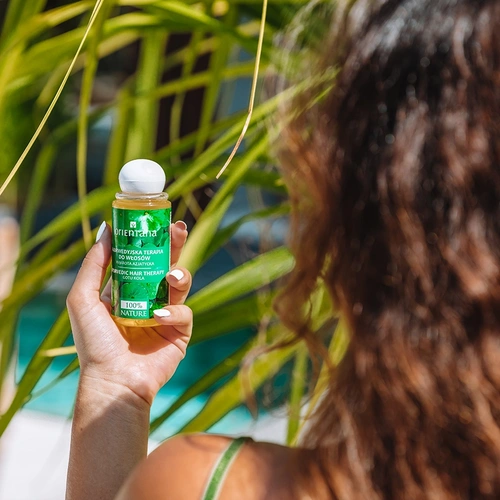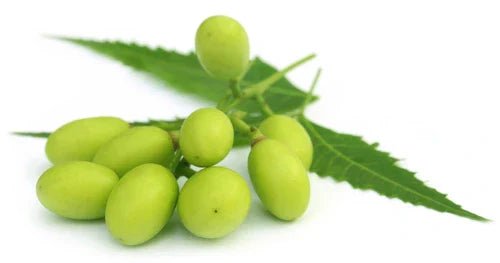What is neem?
Neem, also known as Indian neem ( Azadirachta indica ), is a tree native to India and Southeast Asia that has been used for centuries in Ayurveda , the traditional Indian medicine. All parts of this remarkable plant— leaves, bark, flowers, fruit, and seeds —exhibit a broad spectrum of biological and therapeutic properties. This has earned neem a reputation as one of the most valuable natural raw materials used in cosmetology, healthcare, and agriculture.
Neem oil – properties and use in cosmetics
From the seeds of the neem tree, the characteristic, intensely fragrant neem oil ( Azadirachta Indica Seed Oil ) is pressed, which contains:
- unsaturated fatty acids (oleic, linoleic, palmitic),
- vitamin E ,
- bioactive substances such as azadirachtin , nimbin , salannin .
These compounds give it strong antibacterial, antifungal, antiviral, and anti-inflammatory properties. Neem oil is used in cosmetics:
- for acne and imperfections,
- for the care of seborrheic and problematic skin,
- in anti-dandruff shampoos and products for scalps prone to irritation,
- in body lotions and ointments for eczema, psoriasis or itching.
Neem properties – how does neem work?
All parts of the neem tree are used for their multifaceted therapeutic effects :
- Neem leaves – have cleansing, toning, and astringent properties. They help fight acne and skin infections.
- Neem bark – has antiseptic properties, supports the care of gums and oral cavity.
- Neem flowers – gently tone and soothe the skin.
- Neem seeds – contain the most active ingredients, it is from them that neem oil is obtained.
- Neem fruit – used in traditional recipes, also in Ayurvedic supplements (outside the EU).
Neem properties : has a holistic effect on the skin and body – cleanses, regenerates, helps fight bacteria, fungi and parasites.
What parts of the neem tree are used in cosmetics?
Seeds (grains) – the source of neem oil
- INCI: Azadirachta Indica Seed Oil
- The most commonly used cosmetic raw material.
Properties :
- Strong antibacterial , antifungal , antiviral effects
- Supports the fight against acne , dandruff , eczema , and psoriasis
- Repels parasites and insects (e.g. lice, mosquitoes)
Application :
- Creams and ointments for skin lesions
- Anti-dandruff shampoos
- Anti-acne and antibacterial preparations
- Protective cosmetics for the scalp and body
Neem leaves
- INCI: Azadirachta Indica Leaf Extract/Powder
- Often used in the form of powder or water/glycerin extract .
Properties :
- Cleansing , astringent , anti-inflammatory
- They reduce inflammation and soothe irritations
- They have a slightly exfoliating effect
Application :
- Masks for acne and oily skin
- Antibacterial soaps
- Shampoos and lotions for the scalp
Bark
- INCI: Azadirachta Indica Bark Extract
- Less common in cosmetics, but used locally, especially in India.
Properties :
- Strongly antiseptic and astringent
- Helps with skin infections and inflammation of the oral cavity
Application :
- Toothpastes
- Mouthwashes
- Foot care products
Flowers
- INCI: Azadirachta Indica Flower Extract (rare)
Properties :
- More delicate than leaves and seeds
- Soothing and slightly toning
Application :
- Sensitive skin care
- Creams and emulsions with a balancing effect
Fruits (not very common in cosmetics)
- INCI: Azadirachta Indica Fruit Extract/Oil
- They contain ingredients similar to seeds
- Mainly used in Ayurvedic medicine as extracts for skin treatments.
Orientana cosmetics with neem
Neem is an ingredient in many of our skin and hair care products. Neem in Orientana hair care products, combined with other ingredients, creates a synergistic effect of nature.
Neem hair shampoo – cleansing and balancing the scalp
This neem shampoo is based on an Ayurvedic formula that harnesses the cleansing and anti-inflammatory properties of this plant. Thanks to the presence of neem leaf extract, it has strong antibacterial and antifungal properties, effectively eliminating dandruff and soothing itchy scalp. It also regulates sebum secretion and restores microbiome balance, making it ideal for those with problematic, oily scalps.
Henna for hair with neem – coloring and care in one
Orientana Henna with neem combines natural hair coloring with nourishing properties. Neem strengthens hair follicles and has an anti-inflammatory effect on the scalp, counteracting irritation that can occur during the coloring process. Additionally, its presence helps combat dandruff and gives hair a healthy appearance without drying or weighing it down.
Ayurvedic hair therapy with gotu kola and neem – nourishment and regeneration
Orientana also offers an intensive strengthening therapy with gotu kola, neem, and other Ayurvedic ingredients. The neem in this formula acts as a detoxifier and sebaceous gland regulator, supporting the treatment of scalp inflammation. Combined with gotu kola, which stimulates collagen synthesis and supports microcirculation, neem strengthens hair follicles, prevents hair loss, and accelerates hair growth.
Amla-Bhringraj hair oil with nee m – treatment for damaged hair
In Amla-Bhringraj oil, neem plays a protective and balancing role. It has antioxidant and regenerative properties for the scalp and supports the regeneration of damaged hair follicles. Combined with amla (a source of vitamin C) and bhringraj (a traditional hair-strengthening herb), neem improves hair elasticity and resistance to breakage, and prevents excessive hair loss.
Gotu Kola and Neem Hair Lotion – Stimulation and Soothing of the Scalp
Gotu kola and neem hair lotion is a product that activates hair growth through its anti-inflammatory, antibacterial, and microcirculation-stimulating properties. Neem cleanses the scalp and eliminates factors that can block hair follicles, while gotu kola improves blood circulation and promotes cell division in the hair matrix. Regular use of this hair lotion yields noticeable results in thicker hair and reduced hair loss.
How does neem affect the skin?
Phytochemical composition and biological activity
Neem contains numerous bioactive compounds, such as azadirachtin, nimbin, nimbidol, salicylic acid, flavonoids, triterpenoids, and fatty acids. These substances are responsible for neem's broad spectrum of effects at the cellular and tissue levels. Their synergistic effects influence the skin barrier function, lipid metabolism, and the skin's immune response.
Antibacterial and anti-inflammatory effects
Neem extract exhibits strong antibacterial properties against Gram-positive and Gram-negative bacteria, including Propionibacterium acnes – the pathogen responsible for acne lesions. Additionally, the triterpenoids and flavonoids contained in neem modulate the expression of proinflammatory cytokines (including IL-6 and TNF-α), resulting in reduced skin inflammation and a reduction in papulopustular lesions.
Regulating sebum secretion and cleansing the skin
Neem exhibits sebostatic properties, helping regulate excessive sebum production, making it a particularly desirable ingredient in the care of oily and combination skin. It has a keratolytic effect, helping to exfoliate dead skin cells and unclog sebaceous glands, reducing the risk of blackheads.
Antioxidant and regenerative effect
The phenolic compounds in neem, including flavonoids and vitamin E, neutralize free radicals, delaying the skin's photoaging process. Neem also supports epidermal regeneration and increases the skin's ability to retain water, strengthening the hydrolipid barrier.
Support for the treatment of skin inflammation
Studies show that neem can support the treatment of inflammatory and autoimmune dermatological conditions such as eczema, psoriasis, and atopic dermatitis. It soothes irritations, reduces itching, and accelerates skin repair processes.
How neem works on hair and scalp
Neem leaves and seeds contain a number of phytochemicals and fatty acids, including oleic, stearic, and linoleic acids. These substances possess antibacterial, antifungal, and anti-inflammatory properties, making neem particularly useful for treating scalps prone to inflammation, infection, and dandruff. 
Antifungal and anti-dandruff effect
Neem effectively combats Malassezia fungi, one of the main causes of dandruff. Azadirachtin and other limonoids present in neem inhibit the growth of yeast-like fungi while reducing inflammation and itching. Regular use of neem products (e.g., in shampoo or toner) helps cleanse the scalp and restore its microbial balance. 
Sebum regulation and scalp detoxification
Thanks to its astringent and cleansing properties, neem helps regulate the activity of the sebaceous glands. Reducing excessive sebum production reduces the risk of oily hair and inflammation around the hair follicles. Neem also helps remove toxins and impurities from the scalp, improving its condition and potentially preventing hair loss.
Strengthening hair follicles and stimulating growth 
Neem extract stimulates scalp microcirculation, which improves hair follicle nutrition and may influence the anagen (growth) phase of the hair's life cycle. Additionally, the antioxidants in neem protect hair follicles from oxidative stress, one of the factors that accelerate follicle miniaturization and hair loss.
Treatment of inflammation and eczema
Neem helps alleviate the symptoms of dermatological conditions affecting the scalp, such as seborrheic dermatitis, eczema, and psoriasis. Thanks to its immunomodulatory and regenerative properties, neem supports epidermal repair processes, reduces redness and itching, and limits the development of secondary bacterial infections.
The use of neem in other areas of life
Agriculture and horticulture
Neem is known as a natural pesticide and repellent – used especially in organic farming.
Applications:
- Natural insecticide (biopesticide) – contains azadirachtin , which is toxic to insects but does not harm humans or animals.
- Plant protection – neem protects against aphids, spider mites, thrips, mosquito larvae and nematodes.
- Organic fertilizer – neem pomace (leftovers from oil pressing) enriches the soil and protects the roots against fungal diseases.
Ayurvedic traditional medicine
Neem is one of the most important plants in the Ayurvedic system, valued for its strong antibacterial, antiviral, antifungal and anti-inflammatory effects.
Forms of application:
- Tinctures, capsules, powders – used for infections, skin diseases, parasites and digestive problems.
- Mouthwashes – neem has antibacterial and anti-inflammatory properties, supports the treatment of gum disease.
- Preparations for diabetes – in India and Bangladesh, neem is used as a means of supporting the regulation of glucose levels.
Insecticide and antiparasitic agent for humans and animals
- Neem oil is used to produce sprays that repel mosquitoes, ticks and lice.
- Veterinary shampoos containing neem are used to treat fleas, scabies and other parasites in dogs and cats.
Environmental protection
Neem is used in projects to reclaim degraded lands and combat desertification:
- Phytoremediation plant – cleanses the soil of toxins.
- Anti-erosion barrier – the neem root system stabilizes the soil.
Food industry (niche)
- Neem honey – honey obtained from neem flowers, with antibacterial properties.
- Neem tea – a bitter infusion with detoxifying properties.
- A bitter addition made from neem leaves – in traditional Indian cuisine, sometimes used to cleanse the body.
Other industrial applications
- Cleaning products – neem is a component of natural detergents and disinfecting soaps.
- Paper and organic cosmetics – neem extracts can be used as a natural preservative.
Neem oil - food use in Europe
In the European Union , neem oil (Azadirachta indica seed oil) cannot be legally consumed as a food or supplement because it has not been approved as a Novel Food .
Novel Food Regulations (EU Regulation 2015/2283)
- Azadirachta indica , including neem oil, has been classified as a novel food , as it was not consumed significantly in the EU before 15 May 1997.
- Any product seeking to be approved as a novel food must undergo an authorization process, including a comprehensive safety assessment. There is currently no approval for neem oil as a food ingredient in the EU.
Security notifications
The RASFF system has reported cases of unauthorized products containing Azadirachta indica in supplements imported into the EU
Why is neem oil consumption dangerous?
The oil contains azadirachtin , nimbin , and other bioactive compounds that have insecticidal, antibacterial, and potentially toxic effects upon ingestion . Cases of serious poisoning have been reported, including in infants: encephalopathy, renal failure, metabolic acidosis, and seizures . Oral use is not approved—in EU countries, neem oil is classified solely as a cosmetic or plant protection product, not a food product or supplement.
Legal form of use in the EU
Neem oil is permitted as a biopesticide in organic farming (as a plant protection product), but not as a food ingredient . As a cosmetic , the oil can be used—but only externally , taking into account toxicity and concentration assessments (e.g., azadirachtin). However, ingestion is absolutely prohibited .









